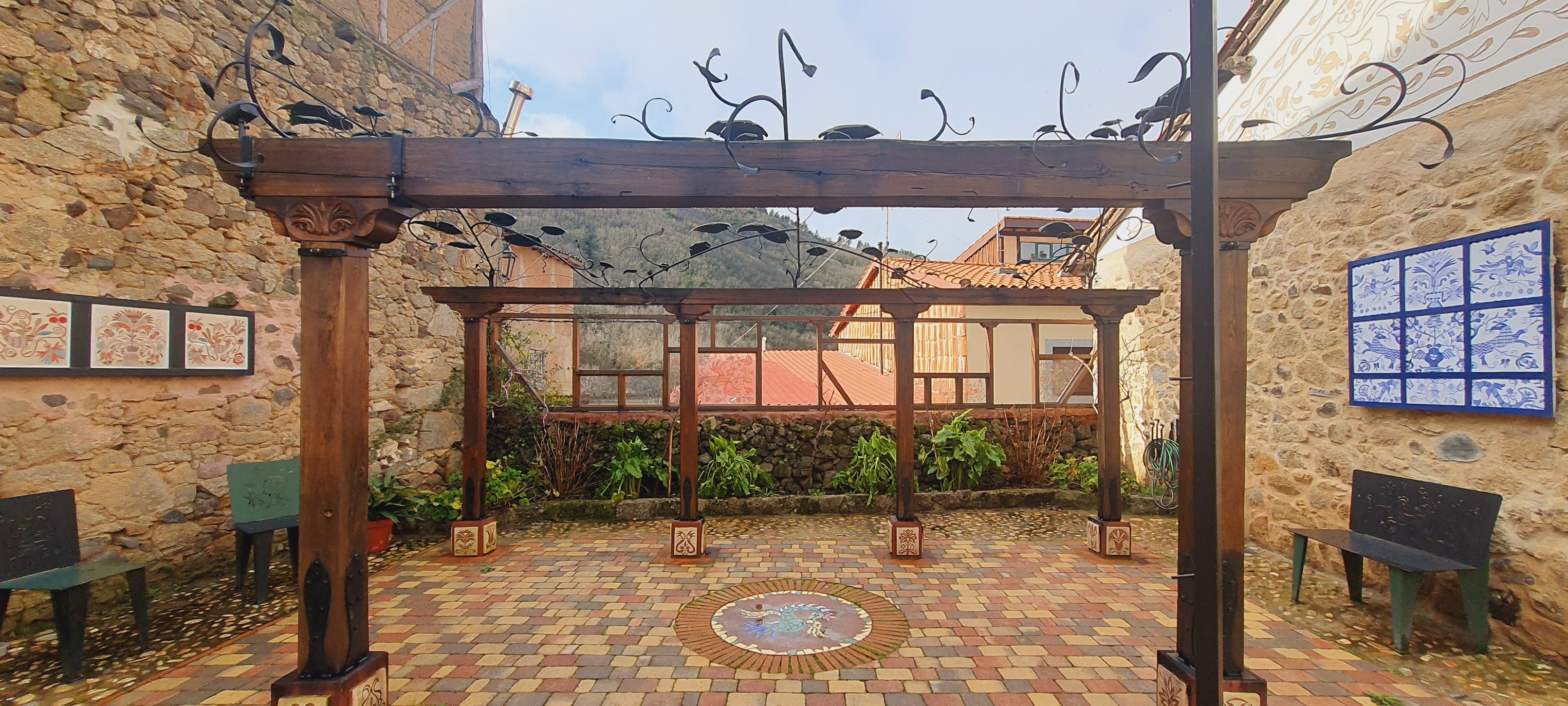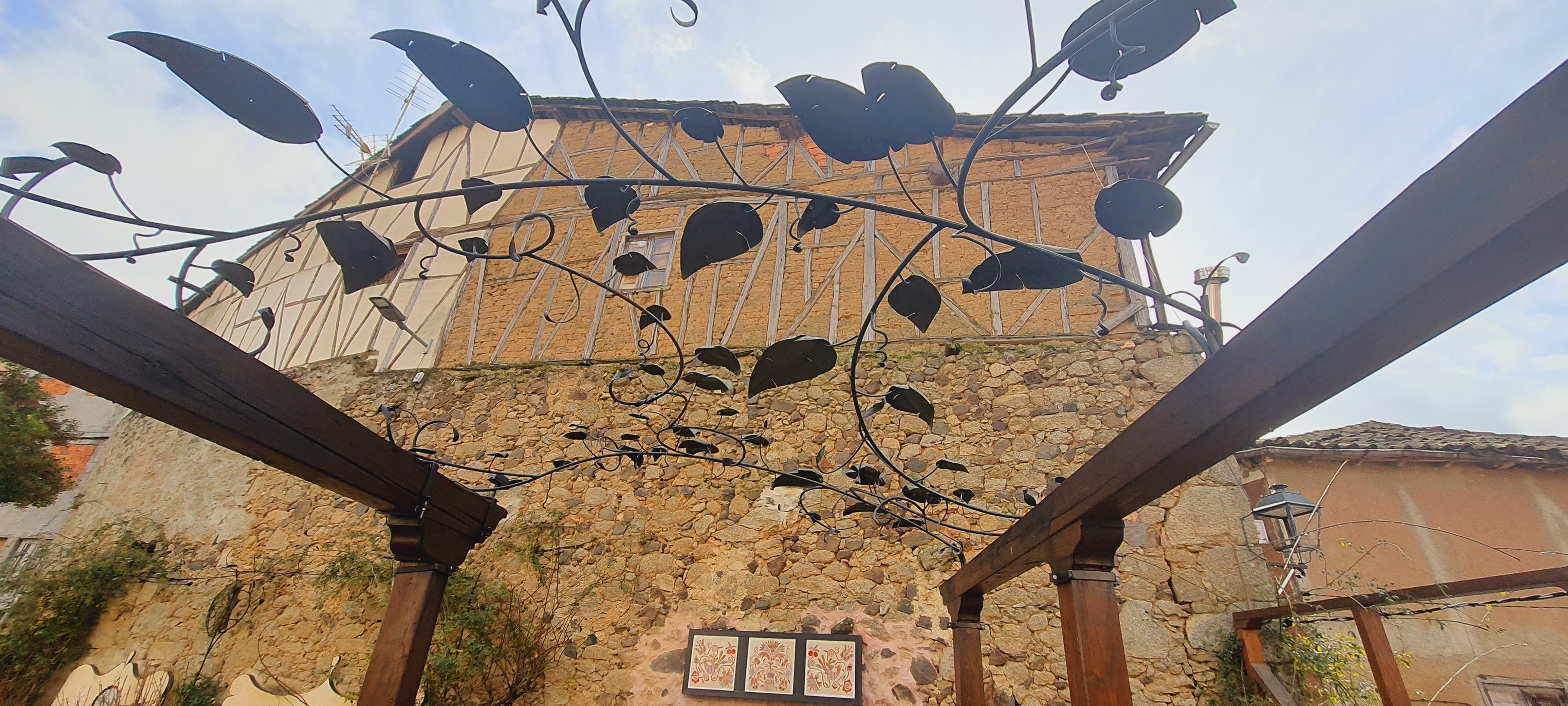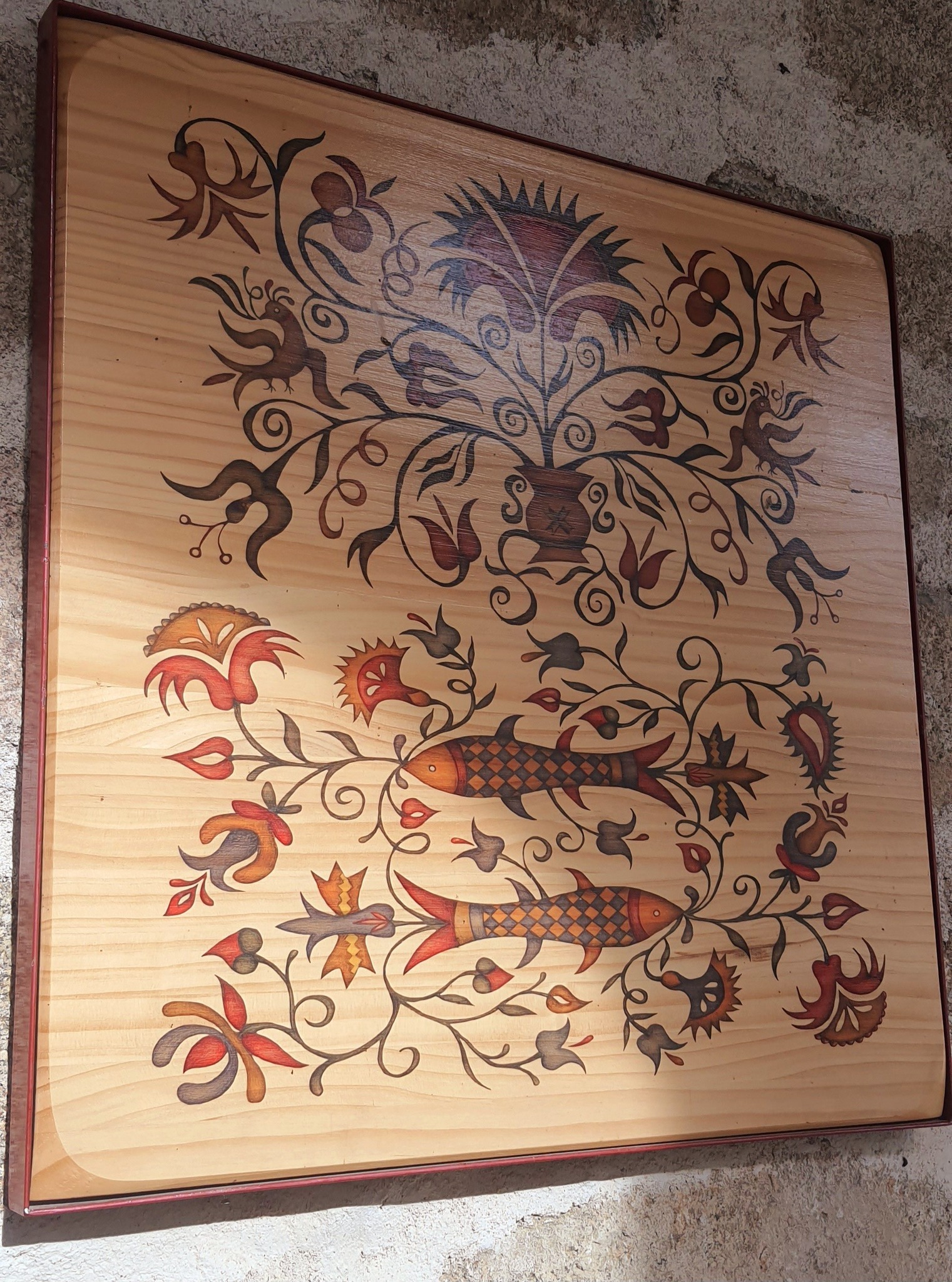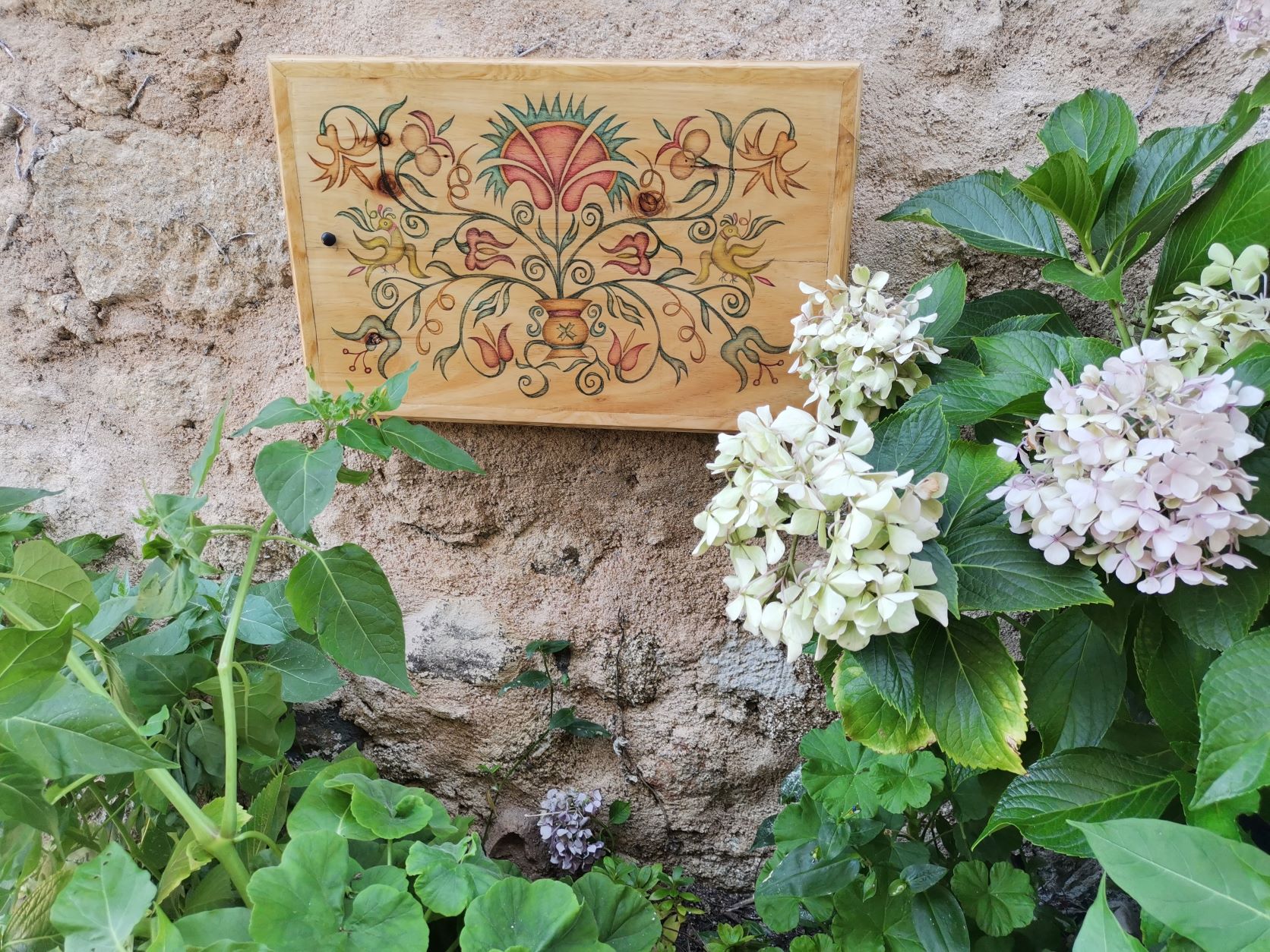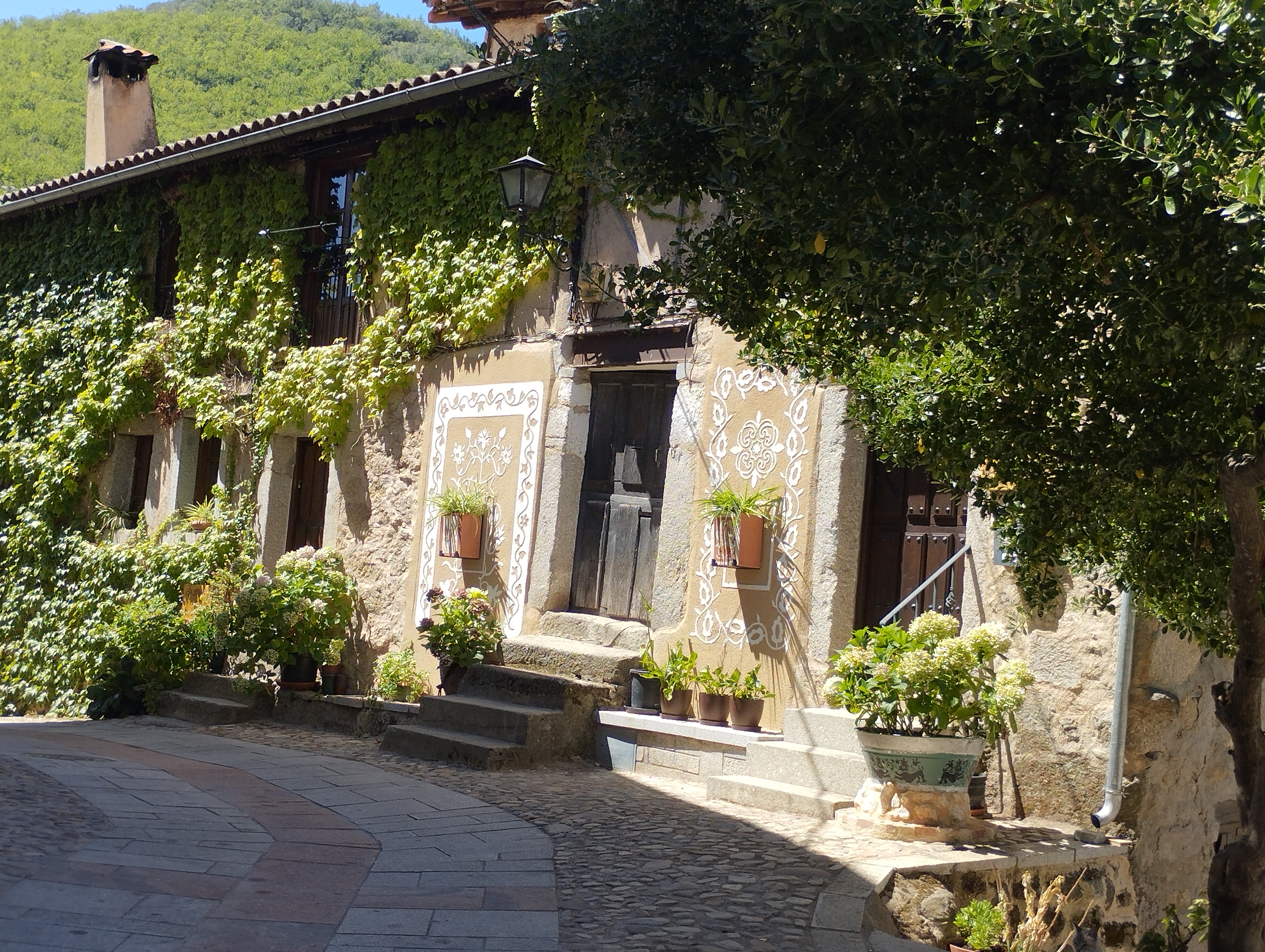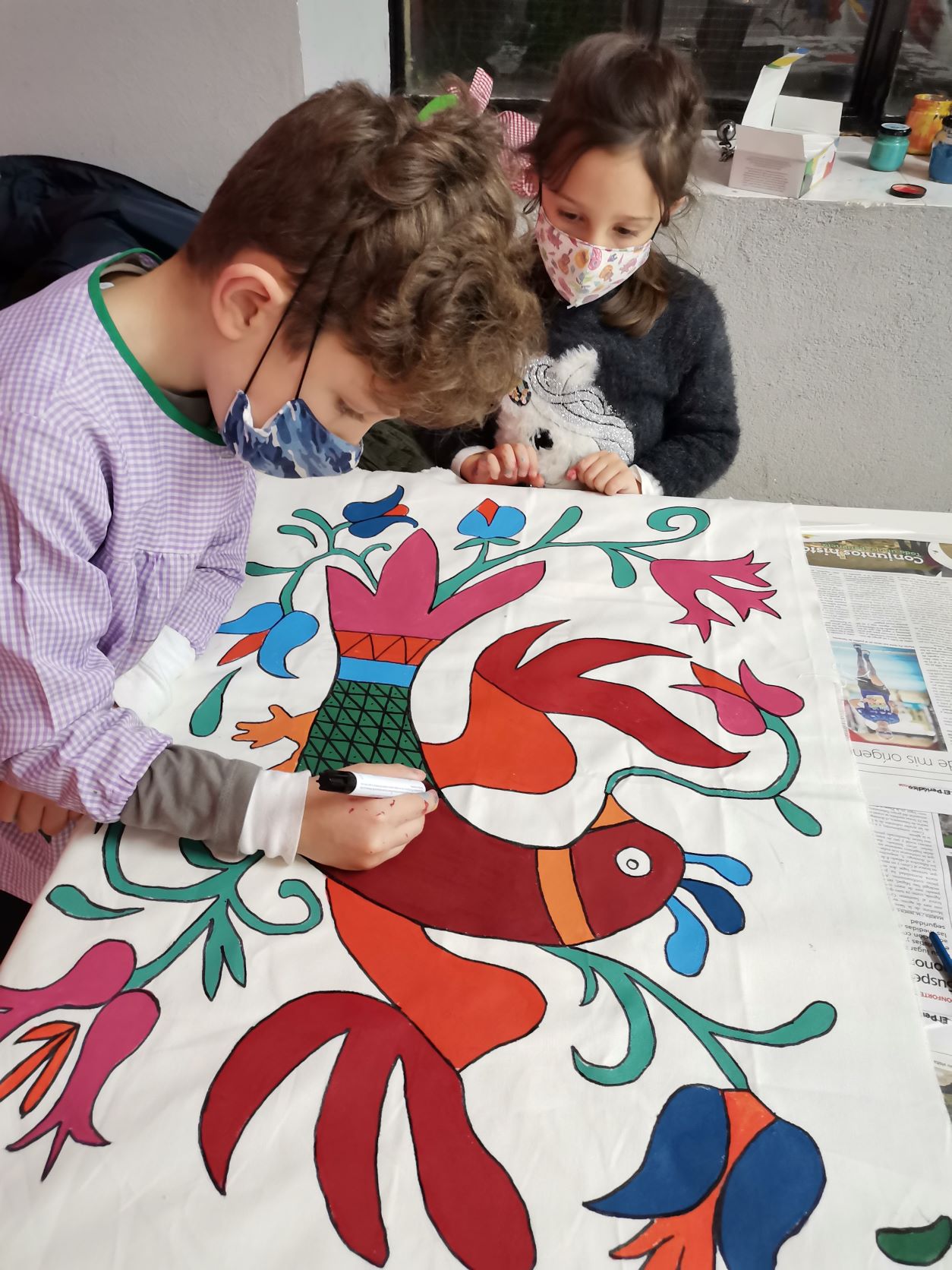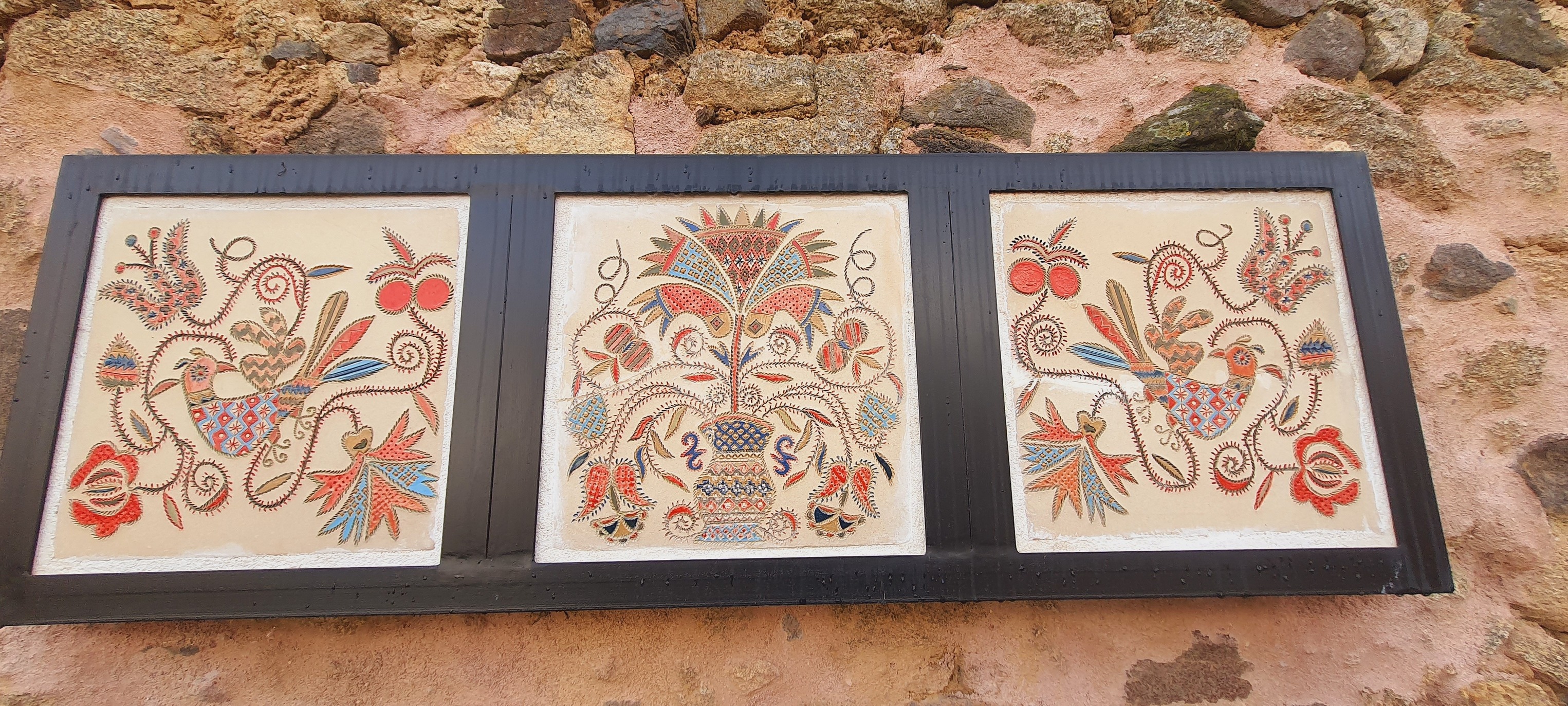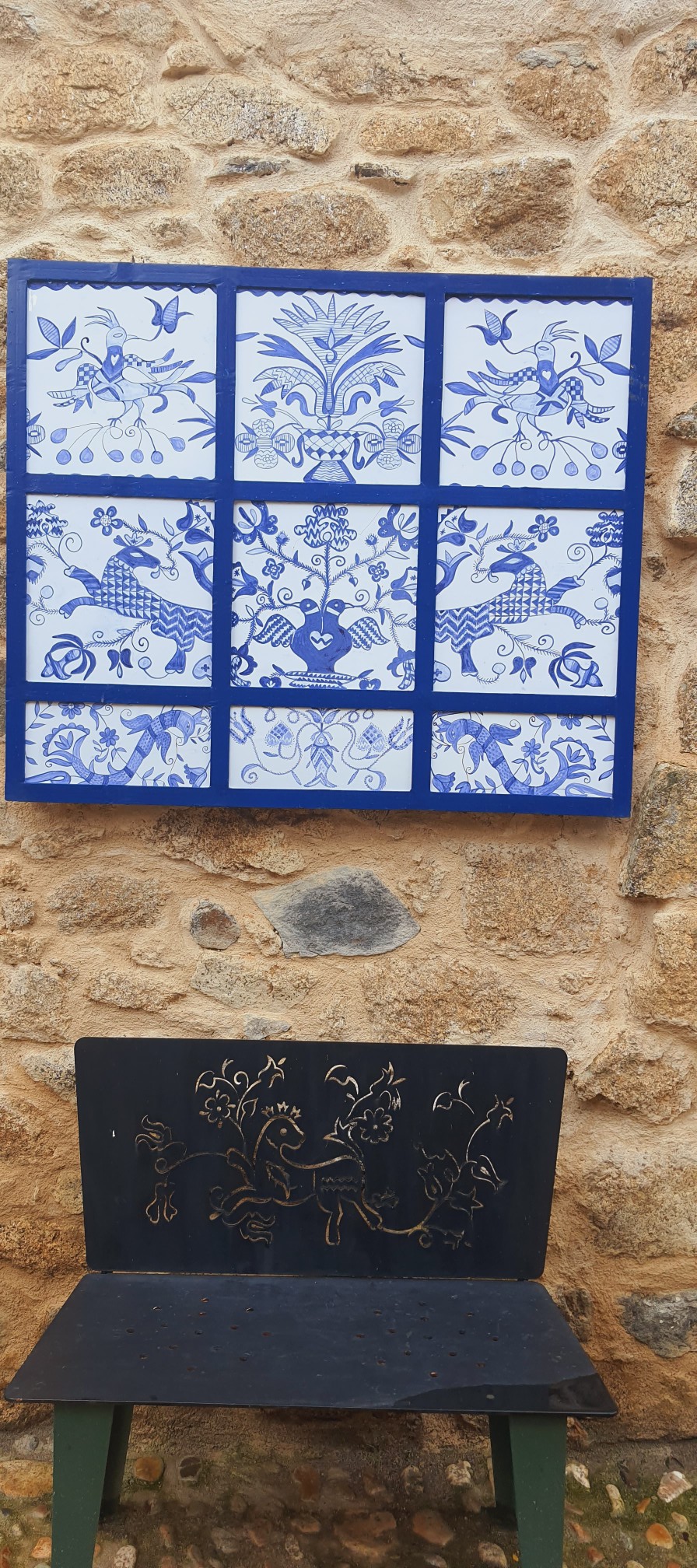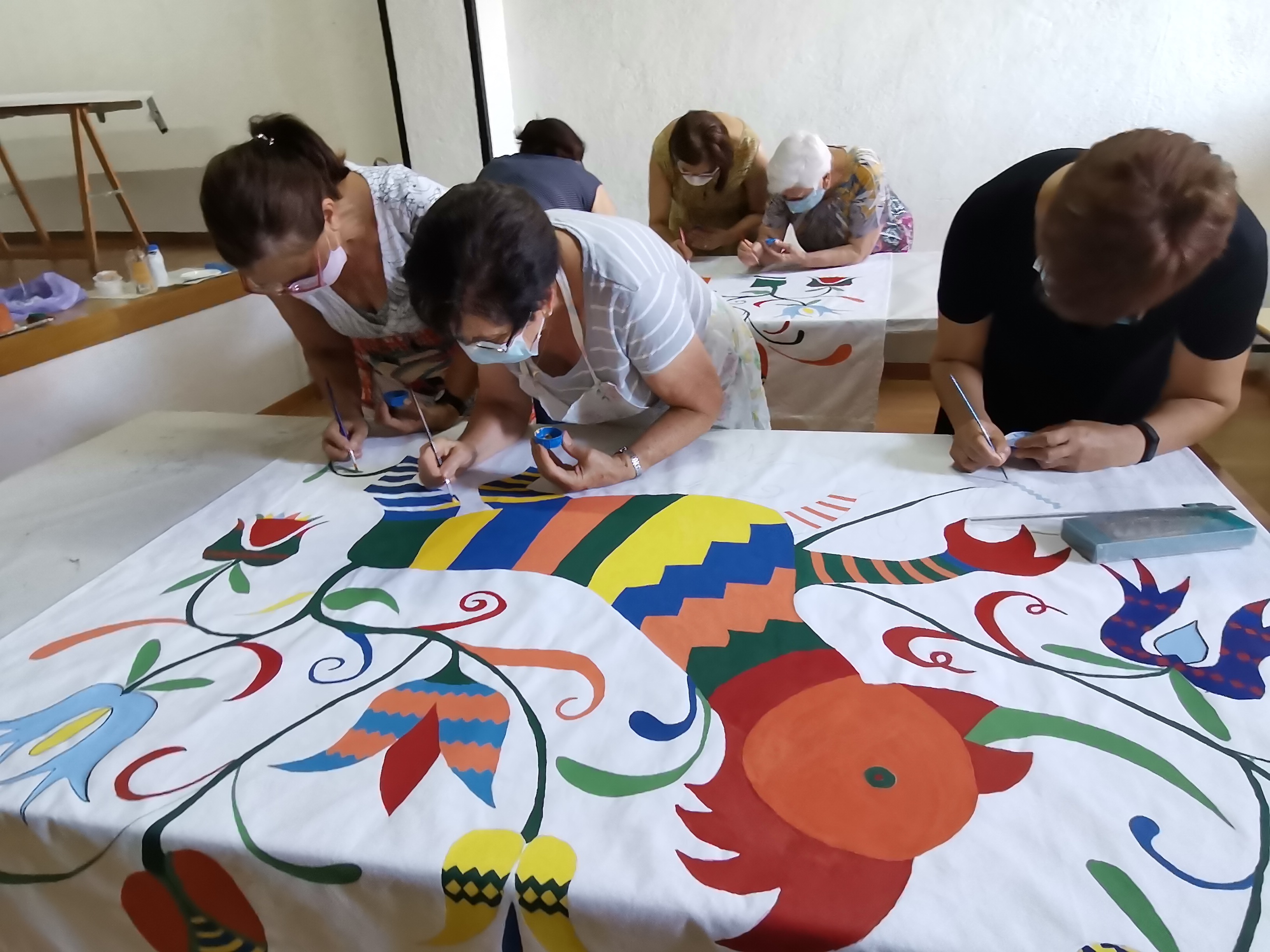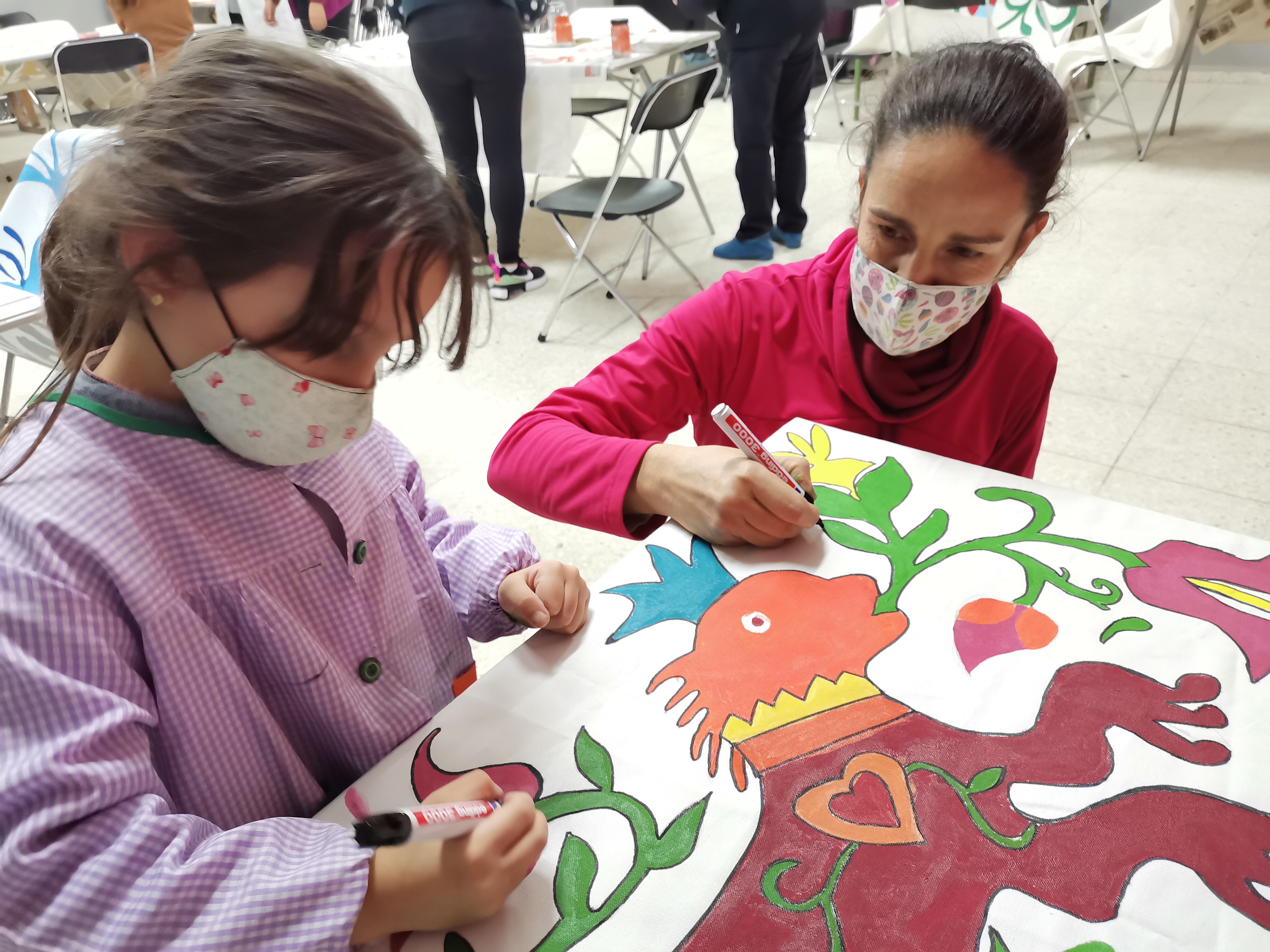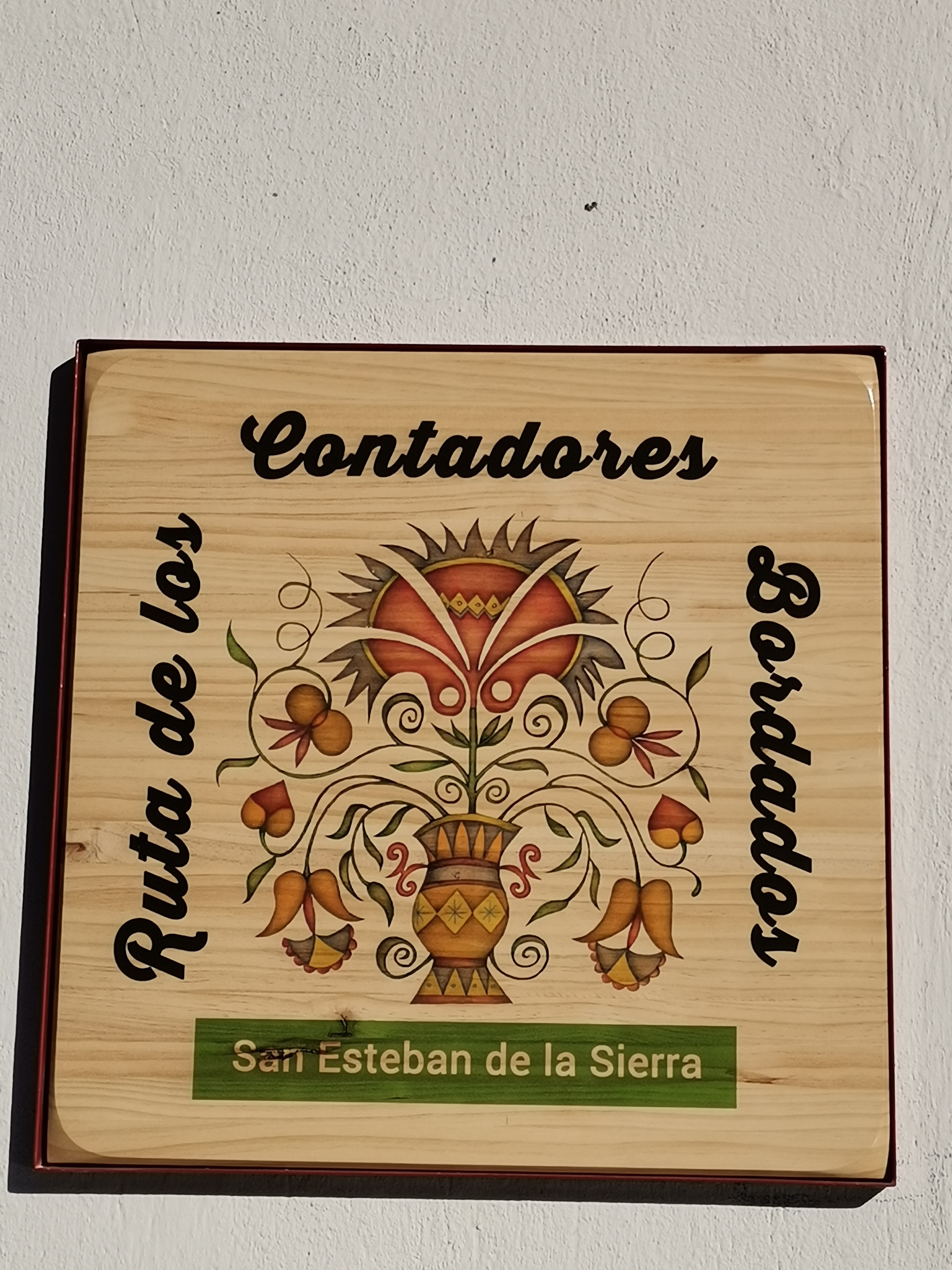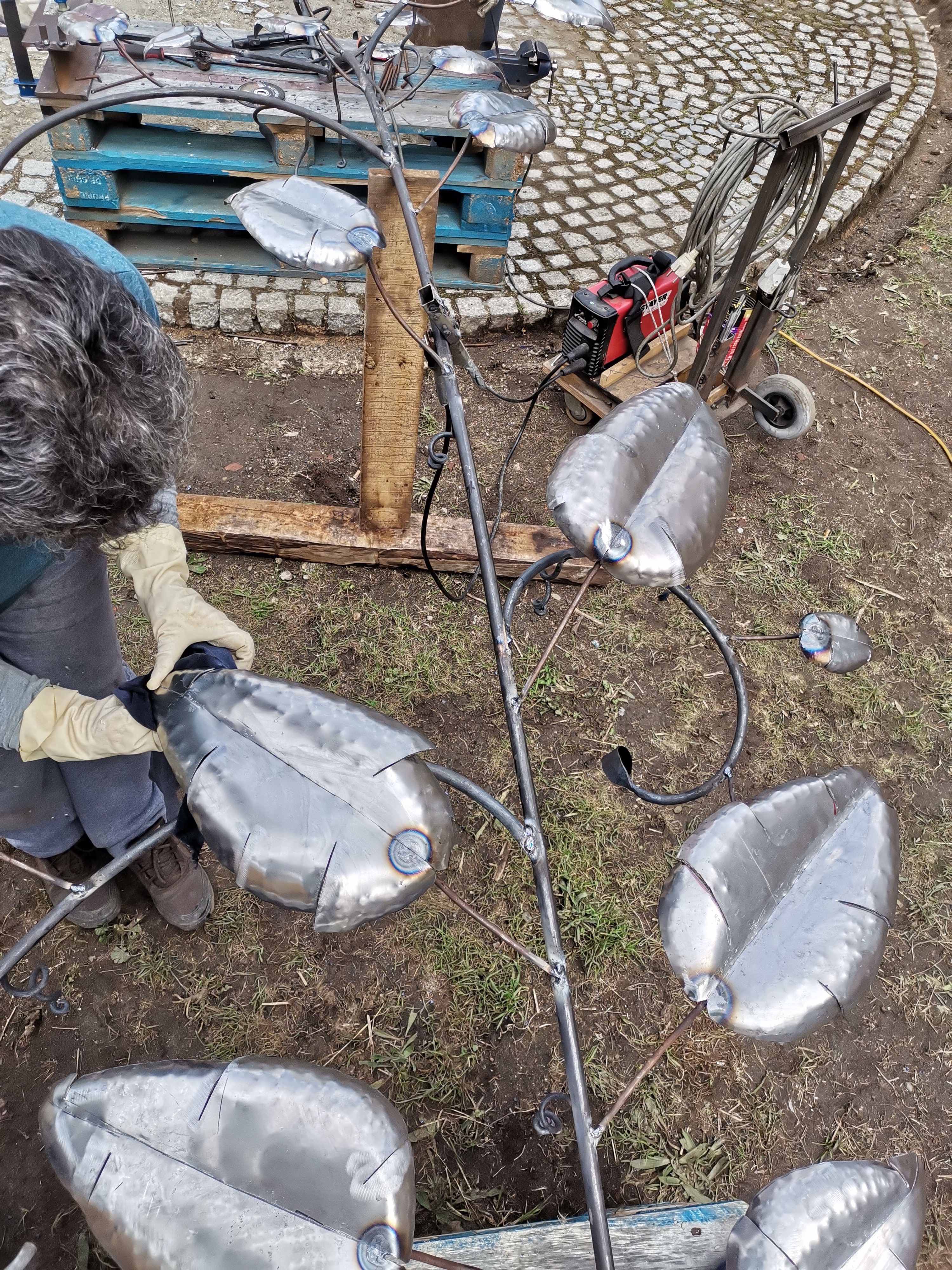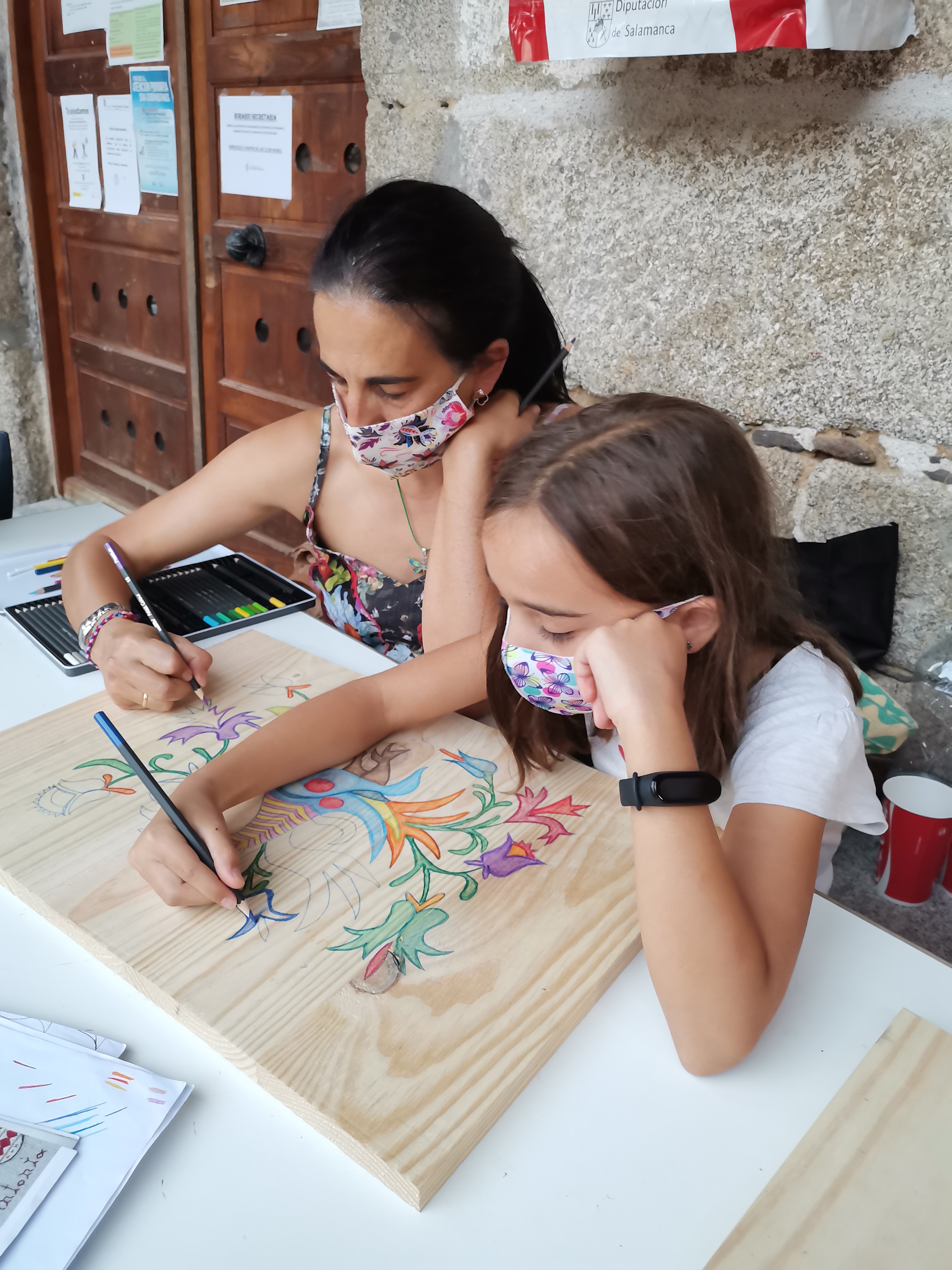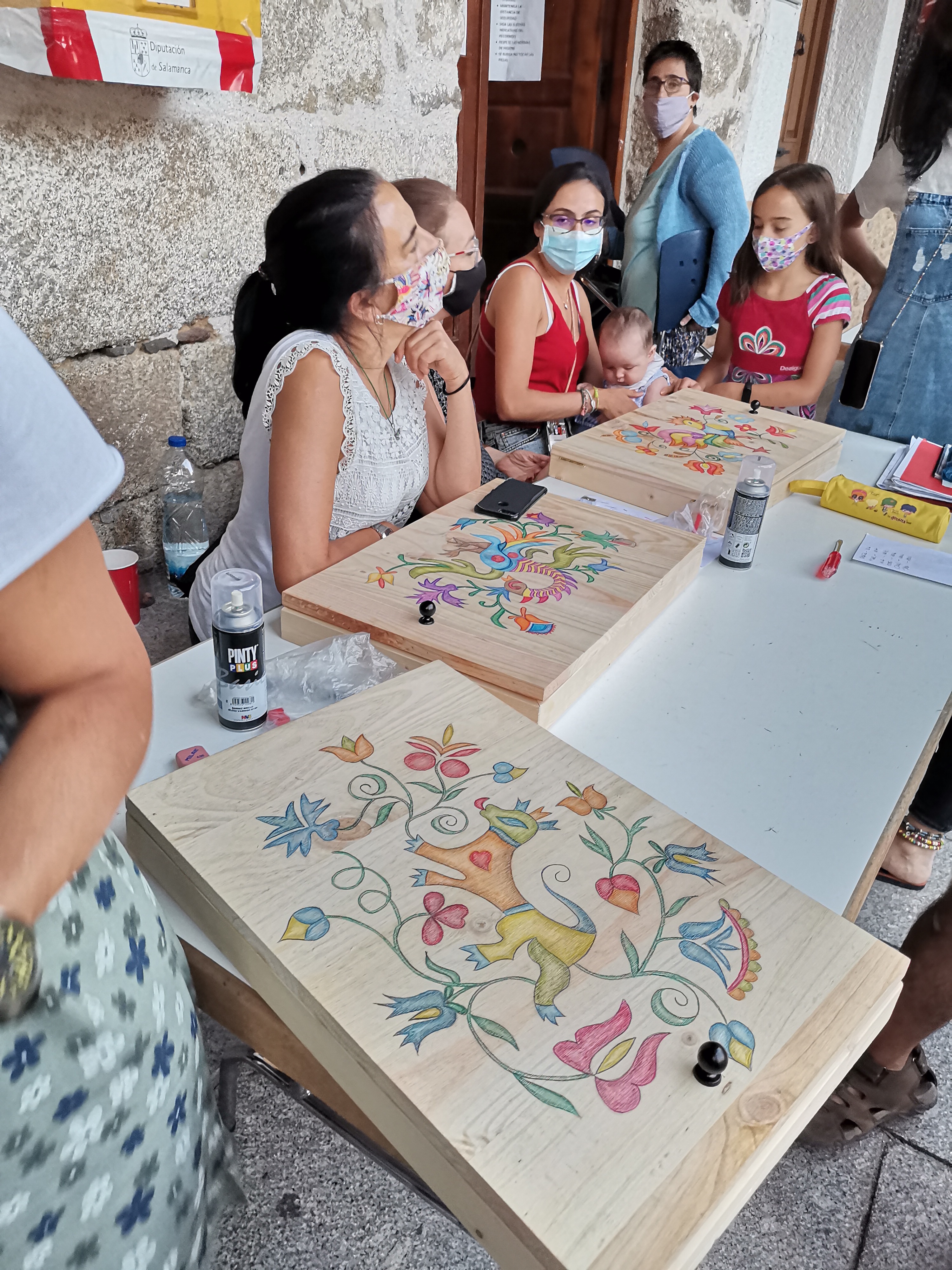Regaining a sense of belonging
ALDABA project
"Ruta de los Contadores Bordados" and "Eco-Cultural Space of El Corral del Cura"
Interprofessional, beautiful and participatory pilot project for the Beautification of Public Spaces with the guiding thread of the Intangible, living and identity-based Cultural Heritage of the Popular Embroidery of the Sierra de Francia of Salamanca
Spain
Local
The pilot project is located in the town of San Esteban de la Sierra, involving the entire rural region of the Sierra de Francia in the Biosphere Reserve of the Sierras de Béjar-Francia in the Province of Salamanca. (Spain)
Mainly rural
It refers to other types of transformations (soft investment)
Yes
2024-12-31
Yes
ESF : European Social Fund
No
No
As an individual partnership with other persons/organisation(s)
The ALDABA project arose from the creation of the first Cultural Design and Innovation Laboratory in rural territories, with the aim of recovering the values of Intangible Cultural Heritage and Traditional Crafts for the benefit of people and the Sustainable Development of the communities that carry them
Since 2018, Red Arrayán's Lab-CREARTE has generated innovative cooperation projects between professionals linked to Applied Arts, Crafts and CCIs with the common thread of Living Cultural Heritage and Identity of the territory
The motivational and aesthetic link of the Iconographic Universe of Popular Embroidery has made possible the involvement of sector players and regular citizens to design and develop new stories and applications in tourist products, handicrafts and in the rehabilitation and sustainable beautification of public spaces in cooperation with local entities, regional government and the European Social Fund
In this line we present the experiences developed in San Esteban de la Sierra between 2021 and 2024 of the ‘Route of the Embroidered (Electricity) Counters’ and the public park ‘El Corral del Cura’, paying tribute to the Artistic Crafts and to the cultural diversity that represents this intangible heritage identity of the territory, transmitting a sense of belonging and a new meaning to the aesthetic, social and educational values that characterize it
We aim to stop or slow the loss of population, knowledge and values associated with traditional arts and crafts in the face of new models of cultural and technological globalization
Through trainings in trades and tutoring unemployed people from vulnerable groups, we achieved a sustainable, inclusive and beautiful project that is being visited and referenced at regional, national and international level, ready to be transferred to other rural territories and generating business models based on culture, traditions, the diversity of applied arts and the creative integration of rural-urban languages
Since 2018, Red Arrayán's Lab-CREARTE has generated innovative cooperation projects between professionals linked to Applied Arts, Crafts and CCIs with the common thread of Living Cultural Heritage and Identity of the territory
The motivational and aesthetic link of the Iconographic Universe of Popular Embroidery has made possible the involvement of sector players and regular citizens to design and develop new stories and applications in tourist products, handicrafts and in the rehabilitation and sustainable beautification of public spaces in cooperation with local entities, regional government and the European Social Fund
In this line we present the experiences developed in San Esteban de la Sierra between 2021 and 2024 of the ‘Route of the Embroidered (Electricity) Counters’ and the public park ‘El Corral del Cura’, paying tribute to the Artistic Crafts and to the cultural diversity that represents this intangible heritage identity of the territory, transmitting a sense of belonging and a new meaning to the aesthetic, social and educational values that characterize it
We aim to stop or slow the loss of population, knowledge and values associated with traditional arts and crafts in the face of new models of cultural and technological globalization
Through trainings in trades and tutoring unemployed people from vulnerable groups, we achieved a sustainable, inclusive and beautiful project that is being visited and referenced at regional, national and international level, ready to be transferred to other rural territories and generating business models based on culture, traditions, the diversity of applied arts and the creative integration of rural-urban languages
Innovative Visibility of Intangible Cultural Heritage
Recovery and Beautification of Public Spaces
Public-private cooperation
Interprofessional and citizen collaboration
Recognition of artistic talents and skills of traditional crafts
An integrative pilot project of hope and innovative perspectives that brings a cultural and creative dimension to the EU Green Deal and Covenant for Skills, in line with the SDGs and the values of the NEB, driving a new model that fosters ownership, public-private cooperation, inter-professional participation, beautiful habitat and sustainable economy in rural territories
The initiative values the benefits of participation and environmental transition through memorable inclusive sustainable experiences at local level, giving space for participatory creation and experimentation through the resignification of the natural and cultural heritage identity of the area, preserving the environmental quality and sustainable usability in all processes of the project of restoration, regeneration, connection with nature and beautification of public spaces in collaborative and inclusive ways
The project reinforces and values the processes of circularity intrinsic to traditional trades, recovering skills and behaviours in the use of materials and energy. By observing the cycles of the ecosystem, we recognise the value of the resources of the environment and of biodiversity, which also provides inspiration for the resulting aesthetic motifs and forms. Using mostly recycled or donated materials from the community, we avoided single-use elements, generating a minimal carbon footprint as most of the activities developed are based on manual craft processes of the local environment, prioritising the use of local materials, reusing the waste produced and repairing them in the processes of beautification of public spaces
It takes into account the aspects of sustainability, from an environmental point of view through the Repair, Reuse, Reduction, Renovation and Preservation of degraded spaces, incorporating solar lighting and drip irrigation systems. It involves the actors in the circular model from the design processes to responsible use of the spaces by the population and visitors
The initiative values the benefits of participation and environmental transition through memorable inclusive sustainable experiences at local level, giving space for participatory creation and experimentation through the resignification of the natural and cultural heritage identity of the area, preserving the environmental quality and sustainable usability in all processes of the project of restoration, regeneration, connection with nature and beautification of public spaces in collaborative and inclusive ways
The project reinforces and values the processes of circularity intrinsic to traditional trades, recovering skills and behaviours in the use of materials and energy. By observing the cycles of the ecosystem, we recognise the value of the resources of the environment and of biodiversity, which also provides inspiration for the resulting aesthetic motifs and forms. Using mostly recycled or donated materials from the community, we avoided single-use elements, generating a minimal carbon footprint as most of the activities developed are based on manual craft processes of the local environment, prioritising the use of local materials, reusing the waste produced and repairing them in the processes of beautification of public spaces
It takes into account the aspects of sustainability, from an environmental point of view through the Repair, Reuse, Reduction, Renovation and Preservation of degraded spaces, incorporating solar lighting and drip irrigation systems. It involves the actors in the circular model from the design processes to responsible use of the spaces by the population and visitors
Art and Cultural diversity play an important role in social transformation and integration, in line with the values of the NEB, thus the ALDABA project is planned and developed based on the integrative combination of the beauty of the Applied Arts with the rich iconographic universe of the cultural heritage of Popular Embroidery in the territory.
From the outset, the project places the creative process at the heart of what makes it ‘beautiful’, respectfully integrating INNOVATION with technical knowledge and know-how, collective sensitivity and the affective values of immaterial culture.
The aesthetic qualities of the intercultural elements of the popular imaginary of embroidery, transmitted from generation to generation by women artisans in different manifestations of this heritage, witness of a cultural syncretism inherited by the diversity of peoples and cultures that inhabited this territory, are REACTIVATED.
This cultural syncretism is manifested in the combination of medieval aesthetic elements of central Europe with the plastic and compositional contributions of the peoples of the Mediterranean arc, through which interprofessional collaborative design processes have been generated to integrate this aesthetics in an innovative way in the interventions developed by the participating master craftsmen
The project reinforces the sense of belonging and enriches the life of the community by connecting different generations, places and people, facilitating new bonds of openness and mutual care through a new model of participatory artistic intervention that facilitates the recognition of the cultural diversity of this territory, making the origin of the heritage assets visible for the enjoyment of its inhabitants, tourists and visitors.
It provides attractive, friendly and aesthetically beautiful public spaces with the common thread of intangible heritage, making possible a meeting place for cultural activities, people and groups from rural and urban environments
From the outset, the project places the creative process at the heart of what makes it ‘beautiful’, respectfully integrating INNOVATION with technical knowledge and know-how, collective sensitivity and the affective values of immaterial culture.
The aesthetic qualities of the intercultural elements of the popular imaginary of embroidery, transmitted from generation to generation by women artisans in different manifestations of this heritage, witness of a cultural syncretism inherited by the diversity of peoples and cultures that inhabited this territory, are REACTIVATED.
This cultural syncretism is manifested in the combination of medieval aesthetic elements of central Europe with the plastic and compositional contributions of the peoples of the Mediterranean arc, through which interprofessional collaborative design processes have been generated to integrate this aesthetics in an innovative way in the interventions developed by the participating master craftsmen
The project reinforces the sense of belonging and enriches the life of the community by connecting different generations, places and people, facilitating new bonds of openness and mutual care through a new model of participatory artistic intervention that facilitates the recognition of the cultural diversity of this territory, making the origin of the heritage assets visible for the enjoyment of its inhabitants, tourists and visitors.
It provides attractive, friendly and aesthetically beautiful public spaces with the common thread of intangible heritage, making possible a meeting place for cultural activities, people and groups from rural and urban environments
The ALDABA project connects with the objectives of the organisation and with the third core value of the NEB through the implementation of inclusion, equality, accessibility and affordability in all stakeholders involved in the different processes of the project's value chain, maintaining the focus on ensuring equal access to opportunities and resources for all and fostering exchanges between cultures, genders and ages.
The project is based on a positive, open and non-discriminatory approach without characterising social groups according to their differences. Without explicitly labelling any of them, it focuses the attention in some of its activities on vulnerable groups of people, facilitating the recognition of their skills and talents and therefore their social integration in the community.
It has been an open and inclusive initiative, taking into account the physical, cognitive and psychological accessibility of the participating people and groups, and is therefore accessible to all, regardless of gender, racial or ethnic origin, religion or belief, disability, age or sexual orientation.
Considering the needs of the under-represented, through equal treatment and opportunities, has been a value recognised by the under-represented groups and communities, such as the group of women artisans in rural communities, true bearers and transmitters of knowledge of the intangible cultural heritage on which the project is based.
Carrying out an important work of cultural mediation with public and private entities, as well as participating agents, groups and institutions, we have always defended these criteria, safeguarding the principle of equal treatment and social justice with vulnerable groups, favouring access and guaranteeing their participation in the contracts and activities carried out.
The project is based on a positive, open and non-discriminatory approach without characterising social groups according to their differences. Without explicitly labelling any of them, it focuses the attention in some of its activities on vulnerable groups of people, facilitating the recognition of their skills and talents and therefore their social integration in the community.
It has been an open and inclusive initiative, taking into account the physical, cognitive and psychological accessibility of the participating people and groups, and is therefore accessible to all, regardless of gender, racial or ethnic origin, religion or belief, disability, age or sexual orientation.
Considering the needs of the under-represented, through equal treatment and opportunities, has been a value recognised by the under-represented groups and communities, such as the group of women artisans in rural communities, true bearers and transmitters of knowledge of the intangible cultural heritage on which the project is based.
Carrying out an important work of cultural mediation with public and private entities, as well as participating agents, groups and institutions, we have always defended these criteria, safeguarding the principle of equal treatment and social justice with vulnerable groups, favouring access and guaranteeing their participation in the contracts and activities carried out.
Participation is a main axis in the different processes of conceptualization, formulation and development of the project, with a strong focus on women's groups in the area, through the following activities:
- Collaborative design sessions through proposals for cultural immersion in cultural heritage recognizing historical and multicultural origins, leading to ideas, drawings, and designs selected by the participants under the criteria of design, aesthetics, appropriateness and resources.
- Workshops for the application of the iconographic motifs of the Popular Embroidery in new materials and techniques of painting on fabric or wood, like wooden covers decorated with embroidery motifs to conceal the unesthetic electricity meters that tarnish the appearance of the picturesque facades in the historic village. Over 70 covers now embellish its overall appearance, forming the attractive “Route of the Embroidered Meters”.
- Intergenerational activities applying different decorative elements in the space of “El Corral del Cura” with highly participative workshops on chestnut basketry, initiation to artistic ceramics, and creative gardening with a successful campaign of donations of flowers and plants.
These women also participated in the intergenerational animation of other population groups and share results achieved with tourists and visitors.
Another of the targeted beneficiary groups have been unemployed people from vulnerable groups who have actively participated in the project in the processes of training in skills for the discovery of artistic and creative talents through the practice of artistic trades, by means of hiring in insertion contracts.
The combination of disciplines, integrating formal and non-formal knowledge of different participating population groups has been another achievement of the project, exploring new narratives and actively participating in the implementation of some of them, to achieve the common goal.
- Collaborative design sessions through proposals for cultural immersion in cultural heritage recognizing historical and multicultural origins, leading to ideas, drawings, and designs selected by the participants under the criteria of design, aesthetics, appropriateness and resources.
- Workshops for the application of the iconographic motifs of the Popular Embroidery in new materials and techniques of painting on fabric or wood, like wooden covers decorated with embroidery motifs to conceal the unesthetic electricity meters that tarnish the appearance of the picturesque facades in the historic village. Over 70 covers now embellish its overall appearance, forming the attractive “Route of the Embroidered Meters”.
- Intergenerational activities applying different decorative elements in the space of “El Corral del Cura” with highly participative workshops on chestnut basketry, initiation to artistic ceramics, and creative gardening with a successful campaign of donations of flowers and plants.
These women also participated in the intergenerational animation of other population groups and share results achieved with tourists and visitors.
Another of the targeted beneficiary groups have been unemployed people from vulnerable groups who have actively participated in the project in the processes of training in skills for the discovery of artistic and creative talents through the practice of artistic trades, by means of hiring in insertion contracts.
The combination of disciplines, integrating formal and non-formal knowledge of different participating population groups has been another achievement of the project, exploring new narratives and actively participating in the implementation of some of them, to achieve the common goal.
VALUE OF COOPERATION: Since the formulation of the ‘EnTre2 Plan’ and the development of the projects generated within its framework, the organization Red Arrayán has paid great attention to cooperation as an intrinsic value and as a tool for success in projects that require the active participation of stakeholders inside and outside the territory.
For us public-private cooperation is a backbone of the project and a ‘must’ for the success of the actions developed, playing an important role of institutional cultural mediation, enhancing its technical and economic participation.
Along the way, the project has counted on the economic and planning collaboration of the San Esteban Village Council, the Local Action Group, the Salamanca Provincial Council and the Public Employment Service of Castilla y León, providing co-financed funds from the ESF for the recruitment of unemployed people from vulnerable groups in rural areas for projects of general and social interest.
Institutional mediation enabled the 25-year cession of the land of El Corral del Cura belonging to the diocese of Salamanca to the Village Council of San Esteban de la Sierra for its use as an eco-cultural space in a public and participative manner.
Technical advice was provided by organisations like the Foundation of the University of Salamanca, the Hispania Nostra Association, the Department of Culture of the Regional Government of Castile and León and the Ministry of Culture of the Spanish Government.
Receiving information of interest through the participation in regional, national and international forums, such as the RIS-3 (inter-regional working group to define common social and cultural goals) of Castilla y León, the Hispania Nostra Association, the EUROPARC Federation, the Creative Centres Network and the European Cultural Action Federation to which we are associated, using the NET Compass methodology as a working tool throughout the design, development and implementation processes.
For us public-private cooperation is a backbone of the project and a ‘must’ for the success of the actions developed, playing an important role of institutional cultural mediation, enhancing its technical and economic participation.
Along the way, the project has counted on the economic and planning collaboration of the San Esteban Village Council, the Local Action Group, the Salamanca Provincial Council and the Public Employment Service of Castilla y León, providing co-financed funds from the ESF for the recruitment of unemployed people from vulnerable groups in rural areas for projects of general and social interest.
Institutional mediation enabled the 25-year cession of the land of El Corral del Cura belonging to the diocese of Salamanca to the Village Council of San Esteban de la Sierra for its use as an eco-cultural space in a public and participative manner.
Technical advice was provided by organisations like the Foundation of the University of Salamanca, the Hispania Nostra Association, the Department of Culture of the Regional Government of Castile and León and the Ministry of Culture of the Spanish Government.
Receiving information of interest through the participation in regional, national and international forums, such as the RIS-3 (inter-regional working group to define common social and cultural goals) of Castilla y León, the Hispania Nostra Association, the EUROPARC Federation, the Creative Centres Network and the European Cultural Action Federation to which we are associated, using the NET Compass methodology as a working tool throughout the design, development and implementation processes.
The ALDABA project was articulated with the collaborative participation of professionals in different lines of activity, with the creative coworking of Lab-CREARTE being the backbone of knowledge and technical experiences such as architecture, design, historical research or socio-cultural dynamization, along with disciplines of artistic crafts such as wood carving, ceramics, black-smithing, masonry and artistic gardening
The result has led to the innovative project being called “Rural Modernism”, democratizing beauty and appeal of public spaces, socializing art and promoting the combination of structural design with the good craftsmanship of the Applied Arts and the Iconographic Universe of Cultural Heritage as an aesthetic inspiration
Professional disciplines who carry out the activities of the multilevel value chain of the project
- Project management and direction: specialist in project management with the EFQM model
- Historical Research of Cultural Heritage: specialist with a degree in History and knowledge of intangible cultural heritage
- Socio-community animation: specialist with experience in social dynamization and community development in rural areas
- Architecture: professional support in technical and decorative aspects, recovering sgraffito techniques on facades
- Skills training and professional support: specialist in training of trainers
- Interior design and urban furniture: specialist interior designer
- Artistic Drawing: specialist with a degree in Design.
- Artistic Masonry: specialist in artistic facade decoration
- Artistic Forge: graduate in Arts and Crafts
- Artistic Ceramics: graduate in Fine Arts
- Wood Carving: professional woodworker
- Artistic Gardening: experienced artist and gardener
- Dissemination and Communication: specialist in image and Visual Anthropology
- Translation of texts of the QR codes of the ‘Route of the Embroidered Counters’ into English, French and German by the translation faculty University of Salam
The result has led to the innovative project being called “Rural Modernism”, democratizing beauty and appeal of public spaces, socializing art and promoting the combination of structural design with the good craftsmanship of the Applied Arts and the Iconographic Universe of Cultural Heritage as an aesthetic inspiration
Professional disciplines who carry out the activities of the multilevel value chain of the project
- Project management and direction: specialist in project management with the EFQM model
- Historical Research of Cultural Heritage: specialist with a degree in History and knowledge of intangible cultural heritage
- Socio-community animation: specialist with experience in social dynamization and community development in rural areas
- Architecture: professional support in technical and decorative aspects, recovering sgraffito techniques on facades
- Skills training and professional support: specialist in training of trainers
- Interior design and urban furniture: specialist interior designer
- Artistic Drawing: specialist with a degree in Design.
- Artistic Masonry: specialist in artistic facade decoration
- Artistic Forge: graduate in Arts and Crafts
- Artistic Ceramics: graduate in Fine Arts
- Wood Carving: professional woodworker
- Artistic Gardening: experienced artist and gardener
- Dissemination and Communication: specialist in image and Visual Anthropology
- Translation of texts of the QR codes of the ‘Route of the Embroidered Counters’ into English, French and German by the translation faculty University of Salam
The ALDABA project has demonstrated an innovative and exemplary success at the local and territorial level, since there is no similar experience in the rural environment of the region of Castilla y León
The transdisciplinary approach and multilevel commitment of the experience is serving as a reference to other rural territories for the innovative interprofessional combination of artistic and creative technical character with the iconographic aesthetics of Intangible Cultural Heritage, integrating the involvement of various disciplines of artistic crafts with formal and non-formal knowledge through citizen participation, working together for a common purpose of all groups and groups involved for the benefit of various sectors and the community.
The project has articulated its innovative development, based on public-private collaboration and the involvement of different interest groups of technical and citizen character that in an organic and multilevel way, have participated in different scales of commitment, fields of activity and execution times for its development.
In the different phases of design, execution and evaluation, the EFQM model of quality management has been used in an innovative way, by applying it to an Action Plan that incorporates the values and criteria of the NEB Compass, allowing a continuous reflection between the reality of the local context and the external conditions, including the mediation with institutions, the attraction of resources, pushing us to act in several cases as cultural mediators to achieve the desired purpose.
Creating and raising institutional interest at different levels of competence, the project has achieved the connection of stakeholders through various scales of a common commitment. From associations and local administrations, to regional and national governments, counting with the support of UNESCO for the Good Practices carried out in the dissemination of heritage.
The transdisciplinary approach and multilevel commitment of the experience is serving as a reference to other rural territories for the innovative interprofessional combination of artistic and creative technical character with the iconographic aesthetics of Intangible Cultural Heritage, integrating the involvement of various disciplines of artistic crafts with formal and non-formal knowledge through citizen participation, working together for a common purpose of all groups and groups involved for the benefit of various sectors and the community.
The project has articulated its innovative development, based on public-private collaboration and the involvement of different interest groups of technical and citizen character that in an organic and multilevel way, have participated in different scales of commitment, fields of activity and execution times for its development.
In the different phases of design, execution and evaluation, the EFQM model of quality management has been used in an innovative way, by applying it to an Action Plan that incorporates the values and criteria of the NEB Compass, allowing a continuous reflection between the reality of the local context and the external conditions, including the mediation with institutions, the attraction of resources, pushing us to act in several cases as cultural mediators to achieve the desired purpose.
Creating and raising institutional interest at different levels of competence, the project has achieved the connection of stakeholders through various scales of a common commitment. From associations and local administrations, to regional and national governments, counting with the support of UNESCO for the Good Practices carried out in the dissemination of heritage.
The ALDABA Project focuses on 3 approaches that, combined and complementary, have generated an innovative methodological structure of action and evaluation adapted to the characteristics of the project and rural territories
QUALITY MANAGEMENT approach, incorporating methodological tools of the European EFQM model in the different processes of design, implementation, monitoring and evaluation with a multilevel distribution of responsibility
TRANSDISCIPLINARY approach that has integrated knowledge from different disciplines and sectors to address complex and real problems of the eco-cultural territory projecting actions of interprofessional and multilevel cooperation. The project seeks to understand the interconnections between values and human needs and the natural environment, as well as the approach of other levels of reality based on depopulation, the difficulties of access to culture and training in artistic-creative disciplines and the loss of knowledge of craft trades in these territories
Approach of the NEB COMPAS taking into account the values and performance criteria that have served as orientation and focus in many aspects of the formulation, development and evaluation of the project.
Focusing on the final objectives and processes in a coordinated manner, we have taken into account the cultural, social and environmental aspects as basic purposes and pillars of the organization and in the project prioritizing the needs of all forms of life and the planet
The multilateral application of the three approaches in a complementary way has been very useful for the combination of research and perspectives from multiple fields linked to cultural heritage, the beautification of public spaces and urban furniture through the intervention of applied arts, artistic crafts and the CCSI, meaning an innovative experience in rural territories, progressing towards the integration of results from different disciplines and incorporating academic and non-academic knowl
QUALITY MANAGEMENT approach, incorporating methodological tools of the European EFQM model in the different processes of design, implementation, monitoring and evaluation with a multilevel distribution of responsibility
TRANSDISCIPLINARY approach that has integrated knowledge from different disciplines and sectors to address complex and real problems of the eco-cultural territory projecting actions of interprofessional and multilevel cooperation. The project seeks to understand the interconnections between values and human needs and the natural environment, as well as the approach of other levels of reality based on depopulation, the difficulties of access to culture and training in artistic-creative disciplines and the loss of knowledge of craft trades in these territories
Approach of the NEB COMPAS taking into account the values and performance criteria that have served as orientation and focus in many aspects of the formulation, development and evaluation of the project.
Focusing on the final objectives and processes in a coordinated manner, we have taken into account the cultural, social and environmental aspects as basic purposes and pillars of the organization and in the project prioritizing the needs of all forms of life and the planet
The multilateral application of the three approaches in a complementary way has been very useful for the combination of research and perspectives from multiple fields linked to cultural heritage, the beautification of public spaces and urban furniture through the intervention of applied arts, artistic crafts and the CCSI, meaning an innovative experience in rural territories, progressing towards the integration of results from different disciplines and incorporating academic and non-academic knowl
Taking into account the successful experience we can propose the following transferable circumstances and models
ENABLING ENVIRONMENT
- Team of project managers, capable of carrying out cultural and institutional mediation processes, applying horizontal quality models for formulation, planning, development and evaluation
- Group of people and professionals who love Intangible Cultural Heritage to carry out a shared investigation of the origin, manifestations, characteristics, meanings, etc
- Group of people motivated by art, crafts, design and applied arts willing to share processes of design and execution of common interventions and their application to public scenarios
- Availability of public institutions and other stakeholders of the space or territory to get them motivated for the common purpose
TRANSFERABLE MODELS
- Cultural Innovation and Design Lab space as a creative coworking center managed by a private non-profit entity
- Model of training project in practices for unemployed people that facilitating the discovery of creative talents participate in the project by the hand of masters of trade
- Methodology for research and visualization of Intangible Cultural Heritage as a conceptual, imaginary and iconographic basis
- Shared Design generation models based on a common thread such as “multiple intelligences”, “lateral thinking” or the “decomposition of Kandinsky's art”
- QUALITY MANAGEMENT approach, incorporating methodological tools of the EFQM model in the different processes of design, implementation, monitoring and evaluation with a multilevel distribution of responsibility
- TRANSDISCIPLINARY approach that integrates knowledge from different disciplines to address problems or projects of common interest, projecting interprofessional and multilevel cooperation actions
- NEB COMPAS approach taking into account the values and performance criteria that serve as focus and guidance in many aspects of project formulation, development and evaluati
ENABLING ENVIRONMENT
- Team of project managers, capable of carrying out cultural and institutional mediation processes, applying horizontal quality models for formulation, planning, development and evaluation
- Group of people and professionals who love Intangible Cultural Heritage to carry out a shared investigation of the origin, manifestations, characteristics, meanings, etc
- Group of people motivated by art, crafts, design and applied arts willing to share processes of design and execution of common interventions and their application to public scenarios
- Availability of public institutions and other stakeholders of the space or territory to get them motivated for the common purpose
TRANSFERABLE MODELS
- Cultural Innovation and Design Lab space as a creative coworking center managed by a private non-profit entity
- Model of training project in practices for unemployed people that facilitating the discovery of creative talents participate in the project by the hand of masters of trade
- Methodology for research and visualization of Intangible Cultural Heritage as a conceptual, imaginary and iconographic basis
- Shared Design generation models based on a common thread such as “multiple intelligences”, “lateral thinking” or the “decomposition of Kandinsky's art”
- QUALITY MANAGEMENT approach, incorporating methodological tools of the EFQM model in the different processes of design, implementation, monitoring and evaluation with a multilevel distribution of responsibility
- TRANSDISCIPLINARY approach that integrates knowledge from different disciplines to address problems or projects of common interest, projecting interprofessional and multilevel cooperation actions
- NEB COMPAS approach taking into account the values and performance criteria that serve as focus and guidance in many aspects of project formulation, development and evaluati
In line with several SDGs Goals, we address local solutions to global problems with positive results
- Climate change: developing an organizational and project approach based on environmental sustainability but also cultural, social and economic sustainability in peripheral rural and mountain territories.
- Inequality: favouring the participation of people from vulnerable groups such as rural women, people with mental and emotional problems or people in a situation of loss and widowhood, etc.
- Individualism and lack of cooperation: favouring participation and cooperation through a transdisciplinary approach and demonstrating how cultural mediation can make groups and institutions of different ideologies participate in a common objective.
- Conflicts and violence: generating a friendly climate of honesty and coexistence among the people and groups participating in the project, with democratization and transparency of processes and approaches.
- Unemployment and lack of opportunities: favouring the integration and employment of people from vulnerable groups in rural areas through internship training programs, promoting the discovery of creative talents and access to art and universal culture.
- Loss of values: recovering values associated with intangible cultural heritage linked to artisan crafts, applied arts and artistic crafts, which strengthens leadership, social insertion and job creation.
- Loss of identity: recovering the sense of belonging and identity to the eco-cultural territory from a global perspective, recognizing the multiculturality of historical origins and from a free, respectful and responsible approach without falling into nationalisms Recovering cultural values and reinterpreting them in community, promoting intercultural tolerance,
- Mental and emotional health: promoting friendly and shared relationships between individuals and participating groups, providing tools for personal discovery through art and creativity.
- Climate change: developing an organizational and project approach based on environmental sustainability but also cultural, social and economic sustainability in peripheral rural and mountain territories.
- Inequality: favouring the participation of people from vulnerable groups such as rural women, people with mental and emotional problems or people in a situation of loss and widowhood, etc.
- Individualism and lack of cooperation: favouring participation and cooperation through a transdisciplinary approach and demonstrating how cultural mediation can make groups and institutions of different ideologies participate in a common objective.
- Conflicts and violence: generating a friendly climate of honesty and coexistence among the people and groups participating in the project, with democratization and transparency of processes and approaches.
- Unemployment and lack of opportunities: favouring the integration and employment of people from vulnerable groups in rural areas through internship training programs, promoting the discovery of creative talents and access to art and universal culture.
- Loss of values: recovering values associated with intangible cultural heritage linked to artisan crafts, applied arts and artistic crafts, which strengthens leadership, social insertion and job creation.
- Loss of identity: recovering the sense of belonging and identity to the eco-cultural territory from a global perspective, recognizing the multiculturality of historical origins and from a free, respectful and responsible approach without falling into nationalisms Recovering cultural values and reinterpreting them in community, promoting intercultural tolerance,
- Mental and emotional health: promoting friendly and shared relationships between individuals and participating groups, providing tools for personal discovery through art and creativity.
- Recover a sense of belonging by generating new collaborative models of recognition of the living and multicultural cultural heritage of Europe in peripheral rural areas of the Union
- Adapting conventional methodologies to incorporate new innovative ways of beautification of public spaces, integrating traditional aesthetics with the values of the organization in line with the beautiful, sustainable and inclusive values of the NEB
- Generating a successful and exemplary project of public-private cooperation that through the collaborative physical transformation of public places, contributes to the recognition and resignification of cultural heritage through the incorporation of traditional and artistic techniques that connect with contemporary lifestyles and rural-urban languages
- Demonstrating how a regenerative process of public spaces can contribute to re-establish the feeling of belonging, energising different social, economic and cultural sectors with direct impact on sustainable development at local and regional level
- Being exemplary for new projects of beautification of spaces that are already taking place in the area by public and private initiatives of the county
Enabling the relationship and exchange of intercultural experiences across cultures and generations by providing platforms for activities like the IBERBIBLIOTECAS project in 2024 to encourage reading or an intercultural exchange in 2023 with guests from Malawi who brought their innovative smoking technology originally developed for fish and now applied to the locally abundant pork to create new flavours. The whole community participated in both events, turning them into a great celebration of cultural and technological exchange
- Generating the CREARTE business model from where participating craftsmen and artists are receiving orders for furniture and decoration demanded by private and public entities, inside and outside the territory.
- Boosting the crafts, tourism and CCSI sectors
- Adapting conventional methodologies to incorporate new innovative ways of beautification of public spaces, integrating traditional aesthetics with the values of the organization in line with the beautiful, sustainable and inclusive values of the NEB
- Generating a successful and exemplary project of public-private cooperation that through the collaborative physical transformation of public places, contributes to the recognition and resignification of cultural heritage through the incorporation of traditional and artistic techniques that connect with contemporary lifestyles and rural-urban languages
- Demonstrating how a regenerative process of public spaces can contribute to re-establish the feeling of belonging, energising different social, economic and cultural sectors with direct impact on sustainable development at local and regional level
- Being exemplary for new projects of beautification of spaces that are already taking place in the area by public and private initiatives of the county
Enabling the relationship and exchange of intercultural experiences across cultures and generations by providing platforms for activities like the IBERBIBLIOTECAS project in 2024 to encourage reading or an intercultural exchange in 2023 with guests from Malawi who brought their innovative smoking technology originally developed for fish and now applied to the locally abundant pork to create new flavours. The whole community participated in both events, turning them into a great celebration of cultural and technological exchange
- Generating the CREARTE business model from where participating craftsmen and artists are receiving orders for furniture and decoration demanded by private and public entities, inside and outside the territory.
- Boosting the crafts, tourism and CCSI sectors

